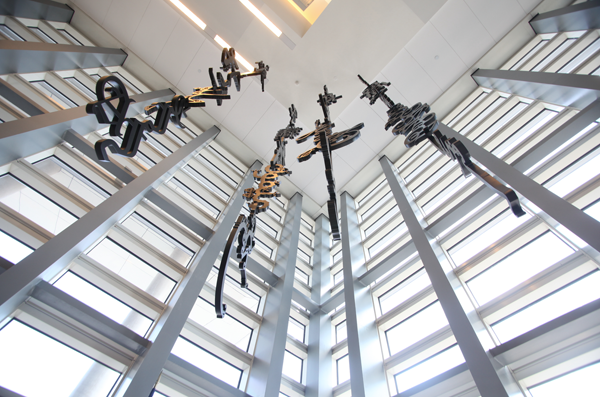 |
Large Medium Small |

Guests invited to the Independence Day celebration at the new US Embassy last week might not know what to make out of the compound. It’s ultra-modern, yet it has a whiff of traditional China in it. The earth tone and the narrow passageways are reminiscent of a Beijing hutong. A smattering of bamboo and a lotus pond are faintly southern China.
Sitting on a 4-hec block in northeastern Beijing, the embassy looks very serious and does not call attention to itself — this in a city where new edifices scream “look at me”.
The self-effacing opening on August 8, 2008, coinciding with the opening of the Beijing Olympics, adds to its low profile. Designed by Skidmore, Owings & Merrill, LLP, Architects (SOM) of San Francisco, with landscape by Peter Walker and Associates of Berkeley, California, it broke ground on May 28, 2004, and cost $434 million.
The interconnected five buildings house some 30 US federal agencies with a total of almost 1,000 employees. The half-million-sq-f floor space, including offices, marine security guard quarters and a parking and utility structure, is surrounded by landscaped ground, and outside it, a perimeter wall typical of government compounds in Beijing.
What turns this government building alive is the objets d’art on display throughout the compound. They are traditional; they are abstract; they are muted; they are colorful; they are invariably thought-provoking.
Twenty-eight artists from the US and China, some Chinese-Americans, fused two cultures in imaginative and infinite formations.
Using media as diverse as painting, sculpture, drawings, works on paper, installation, mixed media and photography, these artists looked to nature as their muse and strove to create something called “landscapes of the mind”.
The objects are not meant to be faithful replicas of what existed in nature, but nature as contemplated and transformed by inquisitive and stylistic eyes and hands.
They are nature expanded by the mind. And in this process of expanding and transcending, they reach the point where East and West no longer exist in dichotomy, but merged into one.
Next time you visit the new US Embassy in Beijing, check out the art collection. It’ll make strictly business slightly more fun.
The Monkeys (top)
There is a folk tale in China about a group of monkeys forming a chain by locking arms and tails and reaching down to capture the moon as reflected in a pond. The installation in the consular section consists of four such “chains”. The Monkeys is the word “monkey” in a dozen different languages, abstractly shaped like monkeys.
Expatriate Chinese artist Xu Bing, a Chongqing native raised in Beijing, created this suspended sculpture in 2001 for the Sackler Gallery in Washington DC, where it remains on permanent display. The piece, of which the embassy has a replica, was presented by the family of Madame Chiang Kaishek in commemoration of her historic visits to the Joint Session of Congress in 1943 and her return to the US Capitol in 1995.
Chinese Pleasures (right)
Betty Woodman’s Chinese Pleasures is an 8-m installation that blurs the line between painting and sculpture. It embodies three distinct moments in the history of Chinese art. With a painted canvas backdrop, it mounts ceramic elements and four red lacquered wooden shelves, each holding a ceramic vase. The right side has the delicacy and refinement of ceramic and bronze money trees from the second century AD. The left is a series of references to 8th-century Tang Dynasty ceramics. The floral images are the artist’s reinterpretation of early 20th-century graphic art used on package labels for firecrackers. Clay is the medium that links so many cultural, physical, and symbolic lineages.
Tulips (far left top)
Jeff Koons’ Tulips is a gargantuan 7-ton stainless steel recreation of the flower that botanical history claims originated in a corridor stretching along the 40-degree latitude between Northern China and Southern Europe. The fantastical sculpture is extremely eye-catching in the embassy’s lotus pond in the consular section.
Prayer banners (far left below)
New York-based Anne Chu created, or rather recreated, these Buddhist prayer banners, which now add a sparkle of vibrant colors to the 8-story chancery building. Highly evocative, they recall a culture remote, mythical and meditative, yet with a burning passion in heart.
Fall/Leaf Swirl (left center)
“The fall tree is made up of red leaves from Chinese, European, and American botanical drawings, embroideries, and decorative motifs. The center is an early Renaissance cloud form, radiating out, containing an infinite bright center. The leaves are swirling in the wind amidst the calm center,” explains Emily Cheng, a New York-based artist who created Fall/LeafSwirl. Cheng borrows images from the natural world to “orchestrate them in a way to express different internal states”.
The Mighty Yangtze (below)
Li Bai (Li Po in old spelling) marveled at it. A significant swath of China is nourished by it.
There are a million ways of seeing and capturing the biggest river in China. And Maya Lin has found her unique approach: She used geologic satellite technology and aerial perspectives, marked the contour of the river with 3,000 pins, emphasizing the linearity and horizontal flow and conveying water patterns with subtle environmental messages.